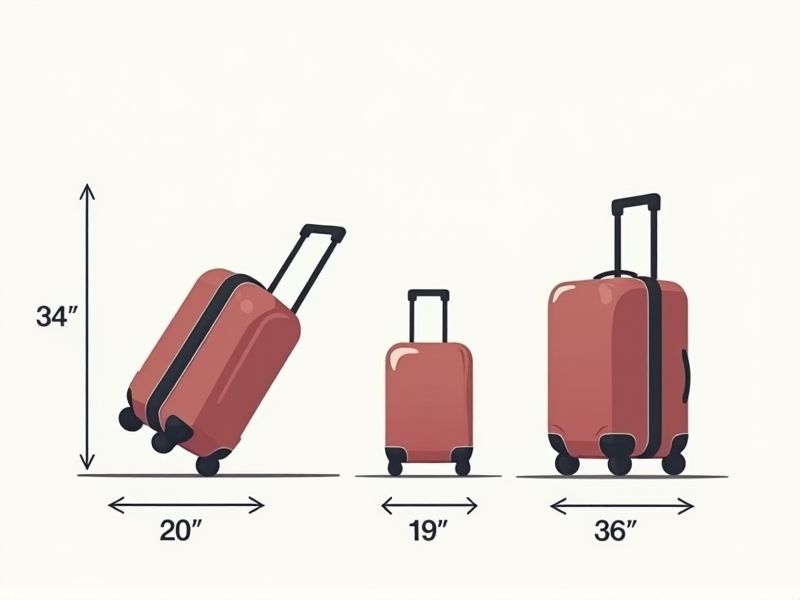
When choosing a carry-on bag for air travel, it's important to check the size restrictions set by airlines to avoid extra fees or having to check your bag unexpectedly. Most major airlines have a standard carry-on dimension limit of 22 inches x 14 inches x 9 inches (56 x 36 x 23 centimeters), including handles and wheels. Always confirm these measurements with your specific airline, as some carriers--especially budget or international airlines--may have slightly stricter requirements. Picking luggage that fits within these guidelines helps streamline your airport experience and ensures your bag can be stored in the overhead compartment without issues.
Airline Specific Policies
Airline-specific policies dictate that most carriers allow carry-on luggage dimensions to range between 22 x 14 x 9 inches (56 x 36 x 23 cm) and 21 x 13 x 9 inches (53 x 33 x 23 cm), accommodating both personal items and overhead compartment storage. Generally, the maximum weight for carry-on luggage is around 15 to 25 pounds (7 to 11 kg), varying by airline. Be mindful that budget carriers often enforce stricter size and weight limits, sometimes charging fees for oversized or additional bags. Always check your airline's website prior to travel to ensure compliance with their latest requirements.
Luggage Weight Limits
Carry-on luggage typically has weight limits ranging from 15 to 25 pounds (7 to 11 kilograms), depending on the airline. Most carriers enforce these restrictions to ensure overhead compartments are not overloaded, enhancing safety and convenience for all passengers. It's crucial to check your airline's specific guidelines, as failure to comply may result in extra fees or having to check your bag. Consider investing in lightweight luggage to maximize your space while staying within weight limits, ensuring a smoother travel experience.
Max Dimensions (22" X 14" X 9")
Carry-on luggage typically adheres to maximum dimensions of 22 inches by 14 inches by 9 inches, ensuring compatibility with most airline regulations. These measurements allow you to pack essentials without exceeding restrictions, preventing extra fees at the airport. Weight limits often hover around 15 to 25 pounds, depending on the airline. Ensuring your bag meets these specifications can significantly enhance your travel experience, making boarding and disembarking more efficient.
Expandable Luggage Considerations
When selecting expandable carry-on luggage, consider the dimensions approved by airlines, typically 22 x 14 x 9 inches, to ensure compliance and convenience. Expandable options can increase packing capacity by 25-30%, accommodating your needs for extra clothing or gear without requiring checked baggage. Look for materials like lightweight polycarbonate or nylon, which provide durability while keeping the weight below the 7-10 pound guideline. Features such as 360-degree spinner wheels and built-in TSA-compliant locks enhance functionality and security during your travels.
Overhead Bin Space Size
Carry-on luggage typically must not exceed dimensions of 22 inches in height, 14 inches in width, and 9 inches in depth to fit comfortably in overhead bins. Airlines often monitor these size specifications strictly, as optimal overhead bin space is crucial for efficient boarding and deplaning procedures. You should weigh your carry-on, as many airlines enforce a weight limit of around 15 to 20 pounds. Understanding these dimensions ensures your luggage will fit properly, preventing delays and ensuring a smooth travel experience.
Under-Seat Storage Capacity
Carry-on luggage designed for under-seat storage typically measures around 18 inches in height, allowing it to fit snugly under most airline seats. This size accommodates approximately 30 liters of capacity, ideal for essentials like personal items, clothing, and electronic devices. Many models feature lightweight materials, often weighing between 3 to 7 pounds, making it easy for you to maneuver through crowded terminals. Opt for designs with multiple compartments to keep your belongings organized and accessible during flights.
Handle And Wheel Allowances
Most airlines stipulate a maximum size for carry-on luggage, typically around 22 x 14 x 9 inches, which includes handles and wheels. The handles should not extend more than a few inches beyond the suitcase body to maintain compliance with size restrictions. Wheels are designed for durability but can add approximately 1-2 inches to the overall height of the bag, affecting fit in overhead bins. Understanding these specifications can help you avoid additional fees and ensure a smoother travel experience.
Fabric Vs. Hardshell Material
When choosing between fabric and hardshell carry-on luggage, consider durability and weight. Hardshell luggage, generally made from polycarbonate or ABS, offers superior protection for fragile items, with an average weight of 6 to 8 pounds for a 20-inch model. In contrast, fabric luggage, often constructed from nylon or polyester, tends to weigh between 4 to 6 pounds and provides flexibility, making it easier to fit into tight spaces. Your choice may also impact storage capacity, as hardshell suitcases usually have a fixed structure, whereas fabric options can expand to accommodate extra belongings, often featuring adjustable compartments.
International Vs. Domestic Flights
When traveling internationally, most airlines enforce a maximum carry-on luggage weight limit ranging from 15 to 22 pounds (7 to 10 kg), while domestic flights often have slightly more lenient weight restrictions. The typical dimensions for carry-on bags are approximately 22 x 14 x 9 inches (56 x 36 x 23 cm) for international flights, ensuring compliance with both the airline and airport regulations. You should be aware that certain international routes may require additional documentation for carry-on items, such as security regulations regarding liquids, which is capped at 3.4 ounces (100 ml) per container. Understanding these standards can help streamline your boarding process and enhance your overall travel experience.
Accessibility And Maneuverability
The standard carry-on luggage typically measures 22 x 14 x 9 inches, ensuring it meets most airlines' regulations for cabin size. Prioritizing accessibility, this luggage often features multi-directional spinner wheels, allowing you to navigate through crowded airports effortlessly. Furthermore, many models include external pockets for easy access to essential items, enhancing your travel experience. With lightweight materials, you can expect improved maneuverability, making it easier to lift into overhead compartments while ensuring durability throughout your journeys.
